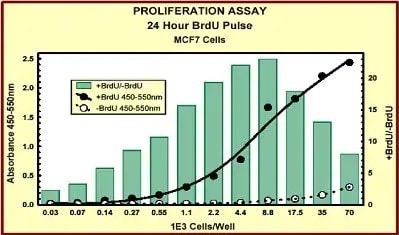BrdU Cell Proliferation ELISA Kit (colorimetric) (ab126556)
Key features and details
- Sensitivity: 40 cells/well
- Sample type: Adherent cells, Suspension cells
- Detection method: Colorimetric
- Assay type: Sandwich (qualitative)
Overview
-
Product name
BrdU Cell Proliferation ELISA Kit (colorimetric)
See all BrdU kits -
Detection method
Colorimetric -
Sample type
Adherent cells, Suspension cells -
Assay type
Sandwich (qualitative) -
Sensitivity
Assay time
2h 30mAssay duration
Multiple steps standard assayProduct overview
BrDU Cell proliferation ELISA kit (ab126556) is an indirect ELISA kit for the detection of BrdU incorporation into newly synthesized DNA of actively proliferating cells. It involves incorporation of BrdU into cells cultured in microtiter plates using the cell layer as the solid phase. During the final 2 to 24 hours of culture BrdU is added to wells of the microtiter plate. BrdU will be incorporated into the DNA of dividing cells. To enable antibody binding to the incorporated BrdU cells must be fixed, permeabilized and the DNA denatured. This is all done in one step by treatment with Fixing Solution. Detector anti-BrdU monoclonal antibody is pipetted into the wells and allowed to incubate for one hour, during which time it binds to any incorporated BrdU. Unbound antibody is washed away and horseradish peroxidase-conjugated goat anti-mouse antibody is added, which binds to the Detector Antibody.
The horseradish peroxidase catalyzes the conversion of the chromogenic substrate tetra-methylbenzidine (TMB) from a colorless solution to a blue solution (or yellow after the addition of stopping reagent), the intensity of which is proportional to the amount of incorporated BrdU in the cells. The colored reaction product is quantified using a spectrophotometer.
The resultant assay is sensitive, rapid, easy to perform and applicable to high sample throughput. In addition to evaluation of cell proliferation, information such as cell number, morphology and analysis of cellular antigens can be obtained from a single culture.
Notes
Abcam has not and does not intend to apply for the REACH Authorisation of customers’ uses of products that contain European Authorisation list (Annex XIV) substances.
It is the responsibility of our customers to check the necessity of application of REACH Authorisation, and any other relevant authorisations, for their intended uses.Platform
MicroplateProperties
-
Storage instructions
Store at +4°C. Please refer to protocols. -
Components 200 tests 500X BrdU Reagent 1 x 15µl Conjugate Diluent 1 x 25ml Fixing Solution 2 x 20ml Peroxidase Goat anti-mouse IgG (2000X) 1 x 15µl Plate wash concentrate (50X) 1 x 90ml Prediluted anti-BrdU detecting antibody 1 x 20ml Stop Solution 1 x 25ml TMB Substrate 1 x 25ml -
Research areas
Properties
-
Storage instructions
Store at +4°C. Please refer to protocols. -
Components 200 tests 500X BrdU Reagent 1 x 15µl Conjugate Diluent 1 x 25ml Fixing Solution 2 x 20ml Peroxidase Goat anti-mouse IgG (2000X) 1 x 15µl Plate wash concentrate (50X) 1 x 90ml Prediluted anti-BrdU detecting antibody 1 x 20ml Stop Solution 1 x 25ml TMB Substrate 1 x 25ml -
Research areas
Images
-
Cell proliferation measured in fibroblasts showing cell amounts vs. optical densities
-
Detection of RH7777 (adherent) cells per well with 2 hour pulse with BrdU. Y axis - left, OD 450-550 nm. Y axis-right, signal -to-noise ratio.
-
Detection of RH7777 (adherent) cells per well with 24 hour pulse with BrdU. Y axis - left, OD 450-550 nm. Y axis-right, signal-to-noise ratio.
-
Detection of Jurkat cells (non-adherent) per well with 2 hour pulse with BrdU. Y axis - left, OD 450-550 nm. Y axis-right, signal-to-noise ratio.
-
Detection of Jurkat cells (non-adherent) per well with 24 hour pulse with BrdU. Y axis - left, OD 450-550 nm. Y axis-right, signal-to-noise ratio.
-
Detection of MCF7 cells per well with 2 hour pulse with BrdU. Y axis - left, OD 450-550 nm. Y axis-right, signal-to-noise ratio.
-
Detection of MCF7 cells per well with 24 hour pulse with BrdU. Y axis - left, OD 450-550 nm. Y axis-right, signal-to-noise ratio.


















